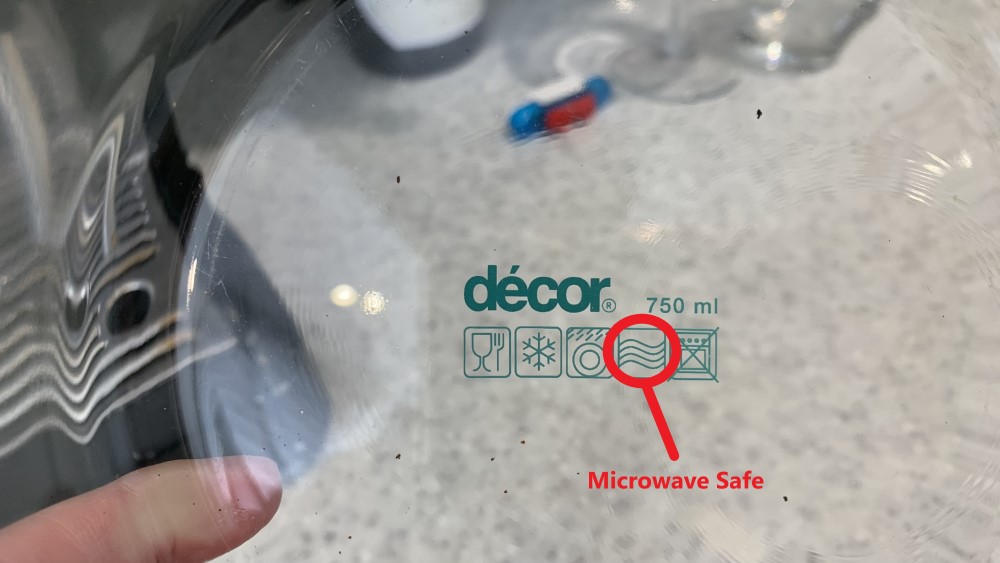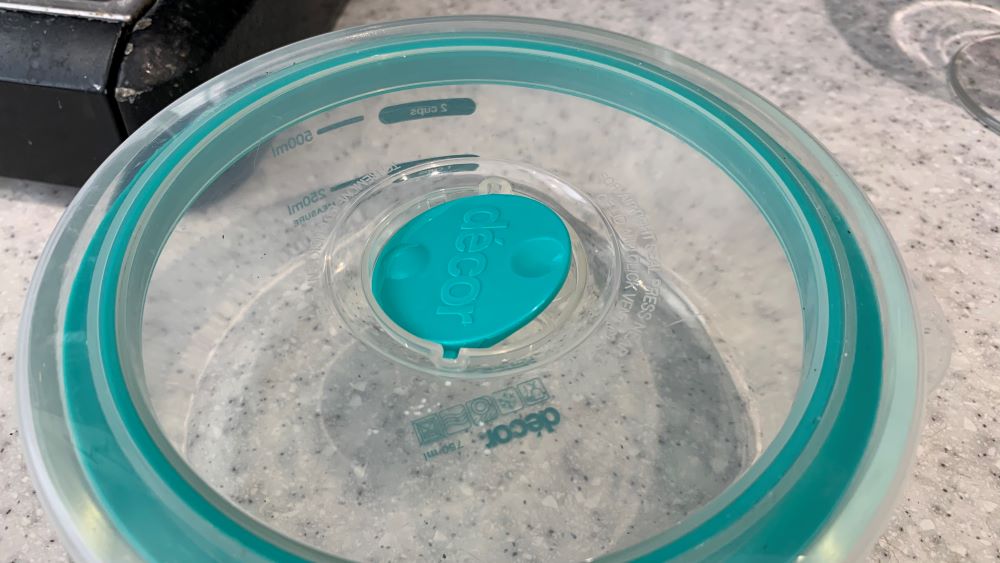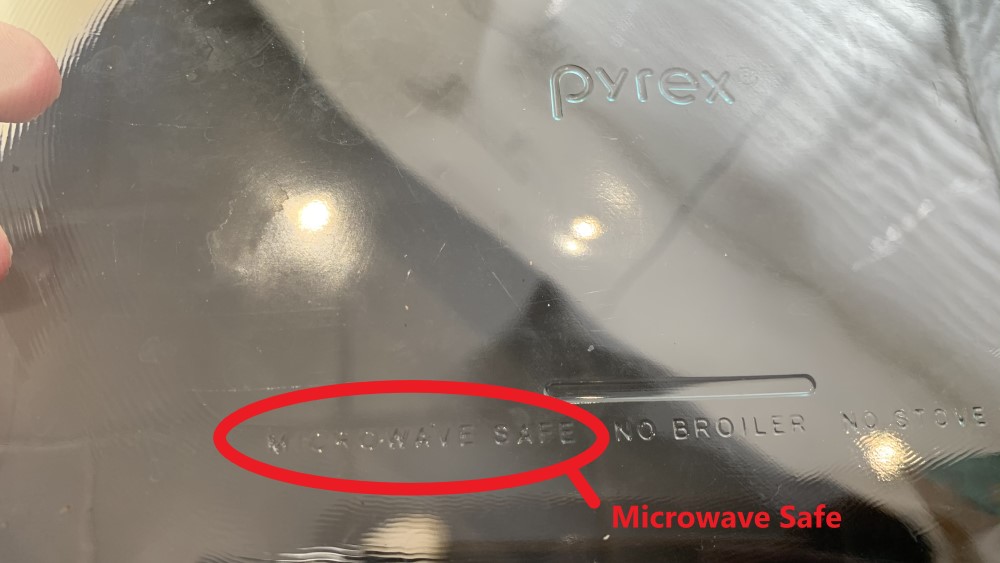Glass containers that are microwave safe will be marked with wavy lines. Other glass containers without this mark may not be strong enough to withstand the process of microwaving. Avoid microwaving frozen or very cold glass as you could risk thermal shock and the glass could shatter.
Toughened borosilicate glass will be strong and able to withstand the microwaving process to heat your food.
Microwaving glass containers, jars or bottles that are not marked with this symbol is a risk as they may not be toughened and therefore cannot withstand the microwaving process.
This article will explain how to safely microwave glass containers and how you can tell which ones were made for this purpose.
This post may contain affiliate links. If you click one of these links and make a purchase, I may earn a commission at no additional cost to you. In addition, as an Amazon Associate I earn from qualifying purchases.

How to know if a glass container is microwave safe
To know if a glass container is microwave safe look for a small square with wavy lines. This is the universal symbol for microwave safe and is a great way to tell for sure that your container was made for the microwave.
These containers will be made from a toughened glass or have substances added to make it stronger. Borosilicate glass for example is made by mixing boric oxide with other glass ingredients such as silica sand, soda ash, and alumina.
The addition of boric oxide to the glass makes it stronger than normal soda lime glass and great for microwaving.
To move a frozen meal in a glass container to the microwave, first, allow it to defrost and come to fridge temperature. The toughened glass will be able to take a temperature change from fridge to microwave but freezer to microwave puts it under more pressure than necessary.
Check out this glass container pack that is microwave safe on Amazon.
Look for the symbol
for the symbol
The easiest way to tell if a container is microwave safe is to look for the symbol which will look like wavy lines. This will usually be on the bottom of the glass, molded in so it is always there even when you take the label off.
There are a range of glass containers that are microwave safe including Pyrex which is made from a toughened borosilicate glass. While not technically glass is mixed with boric oxide to make it able to withstand temperature changes and heating in the microwave.
Microwave safe glass containers
Here are some great microwave safe glass containers that I have used at home and work. These are easy to microwave and reheat a pre-cooked meal.

Pyrex
Pyrex container come in a range of sizes and the new ones are made from borosilicate glass. This is tough, comes with a tight fitting lid and can be microwaved. Always open the corner of the lid to allow steam to escape before microwaving.
I have a large Pyrex container that I use for big meals like lasagna and then I use a smaller, square Pyrex container for single meals to take to work and reheat in the microwave.
Check them out on Amazon below.

Rubbermaid
Rubbermaid make great glass containers with bright colored lids that fit well. These are great for individual meals and can go in the microwave safely
Check out Rubbermaid glass containers on Amazon here.

How to safely microwave food in glass
There are a few easy guidelines to follow to safely microwave food in glass containers. Here are my easy guide to success.
Check for the wavy lines
The first step is to look for wavy lines to see if you can find the symbol that says the container is microwave safe. Pyrex containers have opted to write the words ‘microwave safe’ to make it obvious but it can be tricky to see.
This is written on the bottom of my large Pyrex container.

Always lift the lid
It is important when microwaving food in glass containers to make sure the steam escape valve is open or a corner is lifted on a tight fitting silicone lid. This will allow steam to escape and stop it from popping off or becoming damaged.
Steam will build up in the container and it will need a gap to escape through. While lids are great to stop splatters in your microwave, a small gap or hole is important to safely heat up food.

Let the glass container defrost in the fridge
It is important to make sure that glass containers that are frozen are allowed to come to fridge temperature before microwaving. This is as easy as moving the container and the food to the fridge 12-24 hours before you want to microwave it.
Small single use containers will only usually take around 6-12 hours to get to fridge temperatures whole frozen lasagnas need closer to 24 hours to come up to fridge temperature from frozen.
Microwaving frozen container can put the container under a large amount of stress causing shock and possibly breakage.
Don’t use damaged glass containers
Don’t put chipped, broken or very old glass in the microwave. Any cracks or bubbles will be a weak point and the point at which the glass can break when it rapidly changes temperature. Replace any broken or damage glass containers with new to keep you and your food safe.
Can you microwave glass? | Summary
Glass containers can be microwaved if they have the 3 wavy lines which indicate that they are microwave safe. Pyrex containers will usually have “microwave safe” written on the glass and the lid. Microwaving other glass containers without these markings is a risk and should be avoided.
Avoid microwaving glass containers while they are frozen, instead bring them to fridge temperature first. I love storing food in glass containers and they are great for microwaving single serve lunches at work without the need for plastic wrap.
Check out Pyrex from Amazon here.

I am an accredited practicing dietitian, experienced gardener and a dedicated cook. I love writing and sharing my experience so you can learn from my successes and mistakes.
